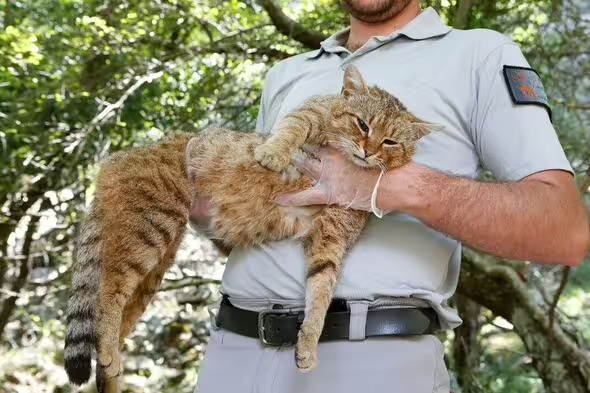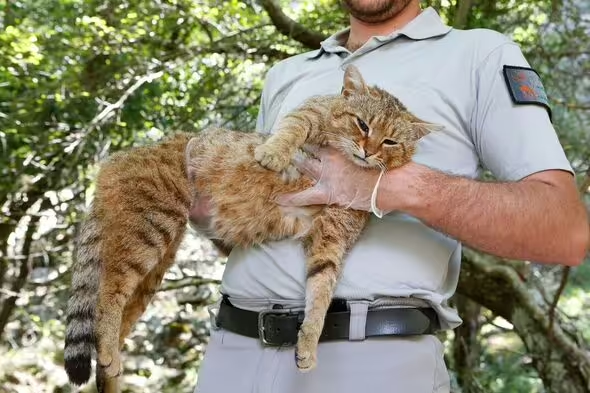📖 Table of Content:
For years, it was just a rumor whispered in the mountains of Corsica. Shepherds spoke of a wild feline that moved like a shadow, had the body of a house cat but the tail of a fox, and left behind mysterious tracks in the dust. It was called the “ghjattu-volpe”—the “cat-fox.” Locals believed in it, but scientists had little proof it existed. That is, until now.
After years of quiet observation and DNA testing, the strange animal once dismissed as a myth has finally been recognized as an official species. And it turns out the cat-fox isn’t just real—it’s also one of the most unique wild felines ever discovered in Europe.
Let’s explore what makes the Corsican cat-fox so mysterious, so rare, and now, so official.
A Cat That Doesn’t Quite Look Like One
The Corsican cat-fox looks like something out of a storybook. At first glance, it resembles a slightly oversized house cat—but the more you look, the stranger it gets.
It has unusually large ears, long legs, and a thick, bushy tail with black rings and a dark tip, more like a fox than any domestic cat. Its coat is dense, with a grayish-brown hue and faint stripes across its body and legs. Even its teeth and whiskers are slightly different from what you’d find on a typical feline.
Its eyes shine a deep amber in the dark, and it moves silently through Corsica’s rocky forests and remote mountainous regions. Locals have always said this animal had something wild and untouchable about it, and now we know they were right.
Found Nowhere Else on Earth
What makes the Corsican cat-fox truly special is that it’s completely unique to the island of Corsica. That’s right—you won’t find this creature anywhere else in the world.
Researchers believe the species may have arrived on the island several thousand years ago, possibly brought by early settlers or stowing away on ancient ships. Over time, it evolved separately from domestic cats and other wild cats in mainland Europe, developing traits suited specifically to the rugged, isolated terrain of Corsica.
The isolation allowed it to become something entirely its own—not quite wildcat, not quite domestic, and definitely not a hybrid. Genetic tests confirmed that the cat-fox has a unique DNA profile, different from both domestic cats and other known wildcats.
It Hid in Plain Sight for Decades
One of the strangest things about the cat-fox is how long it stayed hidden.
Corsican shepherds had been talking about this animal for generations. They’d report sightings of a strange, elusive cat that raided chicken coops, crept through barns, and vanished without a trace. But until recently, scientists dismissed these stories as exaggerations or confusion with feral cats.
Everything changed in 2008, when one of these mysterious animals was caught accidentally in a chicken coop trap. Researchers from France’s National Office for Hunting and Wildlife took notice. Over the next decade, they quietly studied 16 individuals in the wild, gathering hair, scat, and DNA samples, and even placing tracking collars on a few.
In 2019, they finally made the news public. But it wasn’t until 2023 that the Corsican cat-fox was officially recognized as a distinct subspecies. That’s when the legend became fact.
A Perfect Survivor
The cat-fox may look strange, but it’s also incredibly well adapted to life on Corsica.
It’s mostly nocturnal, hunting birds, small mammals, and reptiles under the cover of darkness. Its keen senses help it navigate the rocky forests and dense underbrush where few predators dare to follow. It avoids people and has learned to live quietly in the background, relying on camouflage and silence to stay safe.
Unlike domestic cats, the cat-fox is fiercely independent and solitary. It marks its territory with scent and scratch marks, and has a distinct way of communicating using low growls and purrs. Scientists believe it may even have a unique mating ritual and social behavior, but more research is needed to fully understand its world.
Why It Matters
The discovery of the Corsican cat-fox is more than just a cool story—it’s a reminder of how much mystery still exists in our world. In an age where it feels like everything has already been explored or documented, a brand-new species hiding in Europe is a rare and thrilling find.
It also highlights the importance of local knowledge. The shepherds and farmers of Corsica knew about this animal long before scientists did. Their stories, passed down through generations, kept the legend alive until science caught up.
Now that the cat-fox is recognized as an official species, conservation efforts can begin to protect it. With fewer than 20 individuals known to researchers, it’s likely endangered or at risk. Scientists hope to study it more closely and preserve its habitat before it’s too late.
The Legend Lives On
The Corsican cat-fox may have started as a rural myth, but today it stands as one of the most mysterious and unique feline species in Europe. With its wild eyes, fox-like tail, and elusive nature, it reminds us that some legends turn out to be very real.
And for the people of Corsica, the ghjattu-volpe is no longer just a shadow in the night—it’s a national treasure worth protecting.

